Square cut work
Here on this page, you will find examples of textiles that incorporate the square cut work embroidery technique.

Shirt with square cut work on collar, cuffs, and shoulders
The shoulder pattern is sewn on a finer fabric than that of the shirt. There are no patterns along the edge of the front opening, but there is a square cut work border along the full length of the shoulder piece. The pattern is simple and consists of eight-pointed stars, crosses and small squares within larger squares, which we recognise from counted thread work. The borders of the collar and the cuffs are identical and both have a Hedebo edge consisting of dense rows of Danish buttonhole stitch finished with a row of picots.
Please note
- There is more embroidery on the reverse side of the collar than on the top side. The collar is designed to be turned up
- The sewn buttons at the neck and the cuffs. They consist of a ring of threads, oversewn by Danish buttonhole stitch and provided with a buttonhole bar to which the buttons can be tightly sewn
- At the bottom of the front opening, bars of threads oversewn like a plain whipped hemstitch
- The monogram and its characteristic blue cross stitching





Decorative towel with counted thread work and square cut work
This is made of four equal pieces of fabric sewn together. A purchased fringe was added to the bottom piece. The top border has a pattern of three large squared areas filled with a well composed mixture of square cut work and counted thread work. The border in the middle contains the central motif: two big lions and two women around a tree of life. Above and below the two upper main borders is wide, woven hemstitching surrounded by a narrow woven hemstitch and a zigzag hemstitch respectively. The lowest border has a cross as its central motif and along its sides a stylish flower arrangement surrounded by birds.
Please note
- The square cut work border in the middle with all the small counted thread work patterns which the needlewoman used to fill out empty areas
- The small oblong holes in the lowest wide square cut work border
- The monogram sewn with eyelets and surrounded by red and blue cross stitching
- The stars in the counted thread work of the narrow borders





Decorative towel with square cut work
This is a perfect example of square cut work. The pattern is totally dominated by geometrical forms, different birds, and a tree of life in the form of a flower arrangement. The embroidery is divided into borders by H hemstitch. Atypically, the upper and lower borders have been edged with H hem stitch. This is rarely seen, and the needlewoman has not been able to, or has not wished to seam a corner, but has joined the horizontal hemstitching up to the vertical. Corners in hem stitching were developed at a later date.
Please note
- All the fillings in the motifs are sewn in darning stitch or consist of fabric, except for two of the flowers in the upper centre
- The flower (tulip) in the middle of the top border, with its ”Hvidsøm” leaves
- The cross bar of threads in the flower and leaves of the upper section’s lowest border
- The very stylish and solid plaited warp which was plaited out of a coarser fabric and then attached to the towel




Shirt with ”Hvidsøm” on the collar, shoulder and sleeves.
The ”Hvidsøm” is sewn on a separate piece of fabric and afterwards attached to the shirt. There are small areas of square cut work and cross stitching. The cuffs are embroidered with fillings where threads have been laid on top of the fabric instead of being drawn out as in ”Hvidsøm” fillings. The cuffs are finished in Hedebo edge with dense rows of Danish buttonhole stitch. On the shoulders there are squares, which look like square cut work, both in the small flower and between the two large flowers. Actually this is needle weaving as used in Baldyring”.
Please note
- The rich embroidery on the reverse side of the collar, which suggests an upturned collar
- The small, closely wrinkled pieces held in place by chain stitching and smocking in the area from the embroidered shoulder pieces to the collar
- The four-sided stitching along the edge of the front opening, which continues round the bottom of the opening, and is embroidered with needle lace in buttonhole stitch
- The monogram sewn with red cross stitch in shifting directions





Decorative towel with square cut work and counted thread work
The decorative towel is interesting because it contains nascent ”Hvidsøm”, in which the needlewoman has not yet started to use entwined shapes. The patterns are plain and geometrical. The upper border contains experimental ”Hvidsøm”. The other borders consist of geometrical patterns, flower arrangements, and birds in square cut work and counted thread work . In the border below the initials, stars are embroidered with counted thread work. The initials AHD are sewn in cross stitch and refer to Ane Hansdatter (the daughter of Hans) from Kildebrønde. She was born in 1820.
Please note
- The main borders are surrounded by different sets of darning hem stitch, with rows of square stitching on both sides
- The pattern in the upper border consisting of stars in square cut work placed in diagonal lines, forming large square areas. Inside the squares, flowers are embroidered with square cut work and ”Hvidsøm”. Outside the squares, there are flower arrangements in ”Hvidsøm”
- The bought fringes attached at the bottom






Decorative towel with "baldyring", "hvidsøm", square cut work
The decorative towel shows a rare mixture of the variations in square cut work: ”Hvidsøm”, and ”Baldyring” . The embroidery, filled with interesting details, spreads over a large part of the middle section. It is divided into five borders separated by ten rows of H hemstitching. The borders above and below the border with the monogram, contain ”Hvidsøm” fillings and ”Baldyring” fillings, as well as square cut work. All of it is surrounded by vines, with leaves sewn in outline stitch and satin stitch. The decorative towel consists of four parts. The embroidered part has been lengthened, both at the top and the bottom, by a piece of plain material. A piece of linen with a plaited warp has also been attached to the bottom.
Please note
- Inside the vase in the middle of the bottom border, a relatively rare ”Hvidsøm” filling: needle weaving including cross bars of threads
- The monogram sewn into the border with plain square cut work The monogram itself resembles drawn thread work
- The tulips in all the wide borders




”Knædug” with drawn thread work, counted thread work, and square cut work
The ”knædug” consists of three pieces sewn together. The upper piece is a linen fabric with the initials B and D in cross-stitch. The centre piece contains embroidery in two borders. The upper one is narrow, with square cut work and counted thread work bordered by four-sided hemstitching above and below. The wide border, which forms the main motif, is embroidered with drawn thread work with interlocking. The motif is crowned swans, alternating with flower arrangements and small birds. The bottom piece of fabric consists of a narrow border with a geometrical pattern in counted thread work and a plaited warp.
Please note
- The motifs in square cut work in the top border are whipped at the edge with very unequal long stitches. Is this a part of the pattern, or bad embroidery technique?
- In the two joins of the fabric, herringbone stitching is used to make it look like zigzag hemstitching
- The pattern in the drawn thread work border is not centred
- The middle letter in the monogram has been unpicked
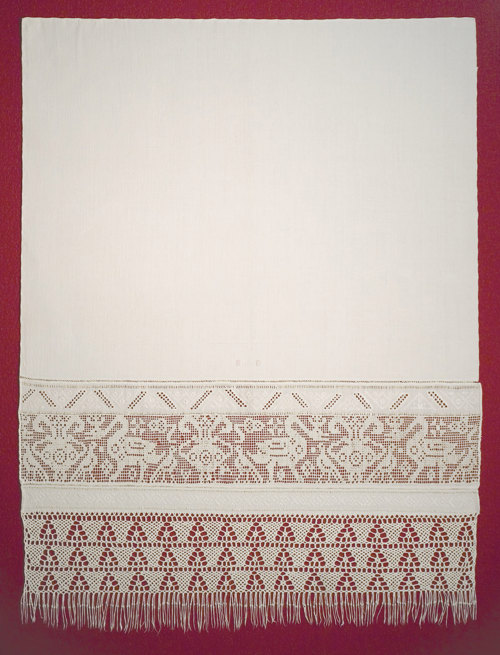



”Knædug” in drawn thread work, counted thread work, and square cut work
The wide border is drawn thread work with whip stitch. The motif is a simple alternation between women with headwear and flower arrangements. Above and below the drawn thread work border are two narrow borders of counted thread work and square cut work. Above the borders is a faded red cross monogram with the initials BID, the date 1839, and a flower arrangement. The drawn thread work border is sewn to the bottom of a piece of fabric. This has been seamed before an open plaited warp, on a narrow piece of fabric of the same quality, was attached.
Please note
- The backstitching around all the small areas of square cut work
- How close to the selvage the withdrawn threads of the drawn thread work are cut
- The stitches holding the pieces of fabric together are made by winding hemstitching, sewn over thicker thread, which spans across the two pieces
- A thin thread is drawn around the small ‘stains’ below the large flowers

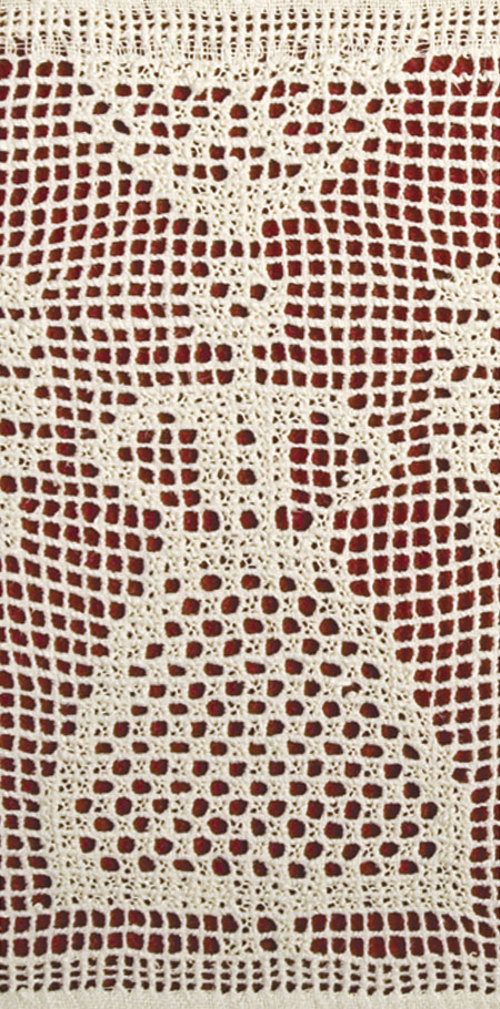




”Knædug” with square cut work and counted thread work
The ”knædug” has a plain pattern with square areas embroidered with counted thread work. Inside the areas, hearts, stars, and squares are embroidered with square cut work and counted thread work. The embroidery is divided into borders by H hemstitching. A loose plaited warp of a more coarse fabric is attached to the ”knædug” like a ‘false’ hemstitch, by weaving over thicker threads which span the two pieces of fabric.
Please note
- How the needlewoman uses her imagination with counted thread work and square cut work patterns in the small diagonal squares which form the characteristic diagonal rows of counted thread work
- How some of the square cut work areas are surrounded by a row of backstitch while others are not
- The monograms embroidered with both red and blue cross-stitching, with crowns flanked by reindeer and cockerels above them
- The embroidery is made by a very experienced needlewoman. The embroidery was given to Greve Museum together with another and, together with these, have been shown in the exhibition Folk Embroideries at the end of the 1950s

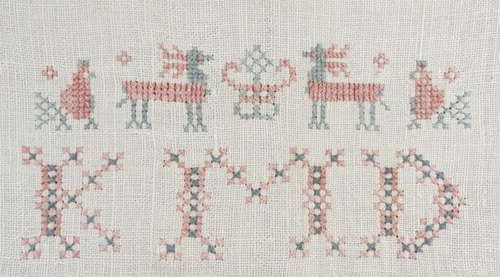



”Knædug” with square cut work
The embroidery is a true example of square cut work, with three borders separated by hem stitching. The upper one is winding hemstitch, the others H hemstitch. The middle border has five vases with flowers. Two birds stand on either side of the centre vase, with a small flower in a vase above. In the upper border, there are paired cockerels with separating tulips. In the lower border, there are paired stags with two types of flower arrangements.
Please note
- How the cross bar of threads is used in the flowers to create ‘life’ in the somewhat rigid embroidery
- How the needlewoman chose to finish the wide border by bisecting the small star-like flower, instead of by embroidering as much as possible, as is seen in many forms of drawn thread work
- The needlewoman has gone wrong when sewing the tulip in the upper border. She has made a wrong cut and has needed to repair the fabric
- How the embroidered date and monogram refer to the initials of the owner and to the year of the embroidery





”Knædug” with ”Hvidsøm” and square cut work
The embroidery occurs in a relatively narrow border at the bottom of the ”knædug”, with winding hemstitch on each side. In the border between the hemstitching, one can see vines with flowers and leaves. The ”knædug” contains both pure net fillings, rose fillings, and woven fillings, as well as fillings of cross-stitching. At the bottom, a plaited warp made of a coarser fabric has been attached with small overcasting stitches. The ”knædug” is given the date 1834 and the initials KID, embroidered in square cut work and surrounded by vines and leaves sewn in chain stitch and satin stitch.
Please note
- The tendrils of the flowers are embroidered in both single rows of chain stitch and in wide outline stitching
- How neatly the needlewoman used blanket stitch on the lower edge, and also on the edges of the two square counted work fillings on both sides of the ”knædug”
- How the plaited warp is a completely framed border
- That the embroidery was presumably made by the same needlewoman who made the decorative towel nr. 4.3, and that KID stands for Kirsten Jens Datter
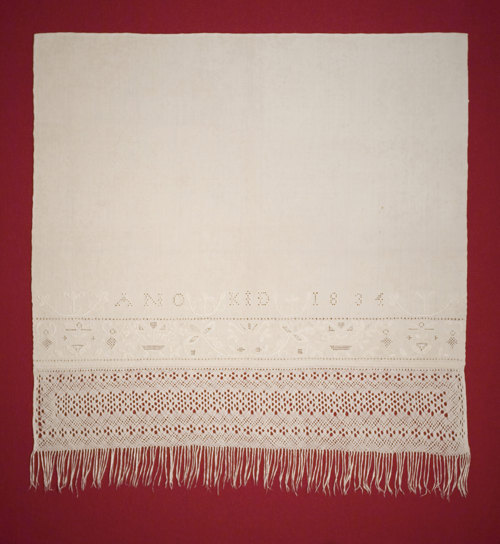


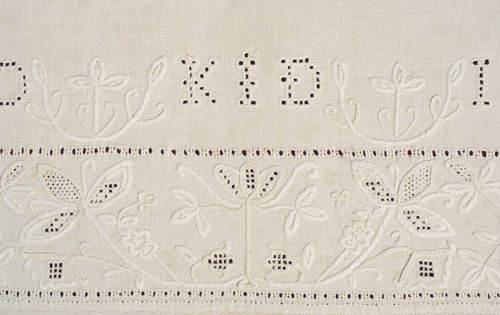
Decorative towel with ”Hvidsøm” and square cut work
The towel consist of three borders;, the two lowest are made of the same fabric while the upper one is of a finer fabric. All three parts must have been embroidered by the same needlewoman because of the regularity of the stitching e.g. the way the chain stitches meet each other in the curvy forms and the repetitive ”Hvidsøm” filling. What cannot be shown in this exhibition is the regularity on the reverse side.
Please note
- That the H hemstitching on the upper piece, and the double row of square stitching with drawn threads on the lower piece, have almost the same appearance
- How the needlewoman did not try to hide the joins in the fabric
- How the fillings in the centre border are embroidered around the flower leaves, and not inside them
- The herringbone stitching between the two rows of chain stitch on the edge of the rosettes in the upper piece, which is repeated in the wavy lines on the two narrow borders, and on the edges of the two flowers at the sides of the lower border



"Knædug" with "baldyring", square cut work, counted thread work and "hvidsøm"
The satin stitch bases are evenly spread over the canvas and bordered with tendrils and leaves in flat stitch. The fillings in the satin stitch bases are simple, consisting primarily of arches, points, and openwork. At the top, remnants of the monogram AADD can be glimpsed. The two leaves above the initials, unlike the rest of the embroidery, are filled with a whitework base. Below, before the warp plaiting, a border with square-cut embroidery featuring deer and stylized trees of life is visible.
Please note
- Two of the square bases in the top border and four in the bottom border are embroidered with cutwork Hedebo.
- The bottom border, with square-cut embroidery, H-hole stitches, and warp plaiting, is of a different fabric quality.
- The embroidered tendrils and leaves are executed with great embroidery skill, whereas many of the satin stitch bases lack this level of expertise.
- The area with the monogram is worn thin, suggesting that old monograms may have been removed and new ones added.





Collar with ”Hvidsøm” and square cut work unpicked from a shift
The flowers are embroidered with single or double rows of chain stitch and filled with crossstitching or square cut work fillings. In the centre, two small flowers embroidered in blanket stitch and chain stitch can be seen. The wide lace is embroidered with dense rows of Danish buttonhole stitching. Between the stitches are small holes creating stars and squared patterns. The collar’s shape and embroidery suggest that it was made in the decade 1810-1820. The collar is characteristic of ”Hvidsøm” and was made by a very skilled needlewoman.
Please note
- The woven hem stitch and its barely visible perforated pattern caused by the collar being made of two layers of fabric
- The vertical lace along the collar’s ends was embroidered first, the horizontal lace last. Then a narrow Hedebo edge was embroidered around the whole collar
- How neatly the lace towards the neck finishes exactly at the edge of the upper hemstitch
- The embroidered ”Hvidsøm” flowers in the corners of the collar’s reverse side which are supplemented by “the chain” along its entire length
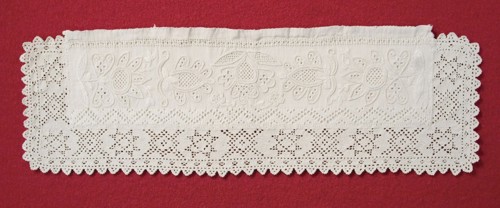


Post pieces with ”Hvidsøm” and square cut work
Post pieces were always found in pairs and were attached to the wooden columns on each side of the door of a small wall cupboard by red silk ribbons. They are unique to the Hedebo area. The two pieces are alike except for the monogram and date. At the top, a Hedebo edge is finished with points and picots. The monogram is made in square cut work. The centre border contains typical flower motifs with ”Hvidsøm” fillings, surrounded by two rows of chain stitching. At the bottom, a bought fringe has been attached.
Please note
- The very beautiful satin stitch
- The needlewoman must have been irritated that the monogram’s ‘G’ did not turn out well
- The fabric inside the numbers and letters is the same, except for three of the spaces in the vertical lines in the numbers and letters, which are filled with whip stitching
- The needlewoman has tried to create ‘life’ in the large flower in the upper ”Hvidsøm” pattern by adding both weaving stitch and drawn thread stitch to the three upper leaves, while the two lower leaves are merely embroidered with drawn thread stitching
